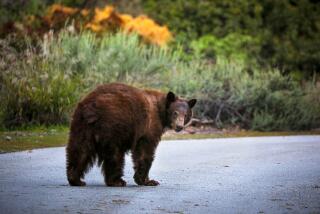OUTDOOR NOTES : Recession Appears to Be Culprit for Poaching
These are hard times for many, and the effects of the recession are apparently being felt not only by the unemployed and underpaid, but by the fish in the streams and animals in the woods.
Such appears to be the case, anyway, in at least some of the more remote regions of California, where “meat-hunting” seems to be on the rise.
“It would be real difficult to make a statement that because of a recession, this is why this or that poaching incident occurred,” said Rich Elliott, regional patrol chief for the California Department of Fish and Game’s Region 1, which includes the eight northernmost counties in the state.
However, Elliott acknowledged that the thought did cross his mind after the discovery of five elk carcasses in a remote part of Shasta County. Witnesses say they heard the report of automatic weapons in the vicinity of the slaughter.
“My goodness,” Elliott said. “You hear about a deer here and there, or somebody may go out and shoot an elk. But why five, all at one time? You’re talking thousands of pounds of meat.”
In Region 3, encompassing 15 counties on the Central Coast from Mendocino through San Luis Obispo, the poaching of wild pigs and deer in southeastern Monterey County and San Luis Obispo County has been increasing, and patrol chief Charles Monroe said hard times may indeed be a factor.
“When times are tough, there are opportunists who not only are concerned with getting meat for themselves, but they see an opportunity to go out and poach and sell deer and elk and pigs and things like that,” Monroe said. “So there becomes a secondary market for low-priced meat, and some people try to capitalize on that and make money by poaching.”
None of the state’s five regions has experienced a noticeable increase in arrests, but some within the department say that doesn’t necessarily mean the wildlife is better off. With such budgetary restrictions as the elimination of overtime, it’s merely another reflection of hard times.
“The hours of patrol that our folks are able to put out there, with all other responsibilities that we have, doesn’t allow us to really keep a handle on or cope with an increasing problem,” Monroe said.
The Sea Shepherd Conservation Society hopes to advance its efforts against poachers and other offenders with the help of a 23-foot Sea Ox donated by a Virginia shark fisherman who reportedly “changed his ways” and wanted his boat “to save lives” instead of take them.
“We’ve decided to use it for whale rescue operations here, for the gill net problems and to step up monitoring,” said Peter Wallerstein, director of the environmental group. “And to go out and patrol five days a week and make sure these guys are abiding by all regulations.”
Wallerstein said his group has already rescued one whale this season and predicted more as the mammals begin their annual migration from the nursing grounds in Baja California to the cold waters off Alaska. Anyone coming across a whale caught in a net should call (213) 543-2888.
Grand Slam: Three Louisiana residents accomplished a rare feat while fishing last summer off Costa Rica’s Isle de Coco. Dino Choest, Damen Choest and Terry Hunter all hooked up at once, and when the lines were all in, one had a blue marlin, one a striped marlin and one a sailfish.
Briefly
BAJA FISHING--Gary Alexander can tell a tale of “one that got away” to family and friends in his hometown of Anchorage after fighting a blue marlin estimated at between 700 and 900 pounds for more than six hours in the waters off Cabo San Lucas.
The marlin broke free between the Golden Gate and Jaime banks, according to Larry Edwards, the Lemon Grove-based representative of the Gaviota Fleet on which Alexander was fishing.
Meanwhile, catches improved during the past week off land’s end, with anglers averaging more than three fish a day. Striped marlin are the prevalent species, followed by dorado and tuna.
Farther north, Victor’s pangas reports a steady bite of yellowfin tuna, most weighing between 15 and 35 pounds.
East Cape: Hotels Palmas de Cortez and Punta Colorada report a few blue marlin to 300 pounds, but tuna and dorado are providing most of the action.
La Paz: The Mosquito Fleet reports “windy and rough” weather, which has anglers mainly fishing the bay. A few dorado are being caught, but sierra mackerel, according to La Concha Beach Resort, are “being brought in by the tons.” Actually, the average catch is 30 to 40 per panga.
TELEVISION--Fish-On! is back on the air, with a new format using guest hosts known for their expertise in a particular field. The first show of 1992, with footage of the 377-pound tuna caught last month by John Carbone and Jim Labanowski, will be shown today at 5:30 p.m. on Prime Ticket.
INSTRUCTION--John Klein, owner-operator of the San Diego-based Qualifier 105, on 1992 long-range fishing prospects, regulations and techniques, Sunday from 11 a.m. to 3 p.m. at Fishermen’s Spot in Van Nuys.
More to Read
Sign up for Essential California
The most important California stories and recommendations in your inbox every morning.
You may occasionally receive promotional content from the Los Angeles Times.










